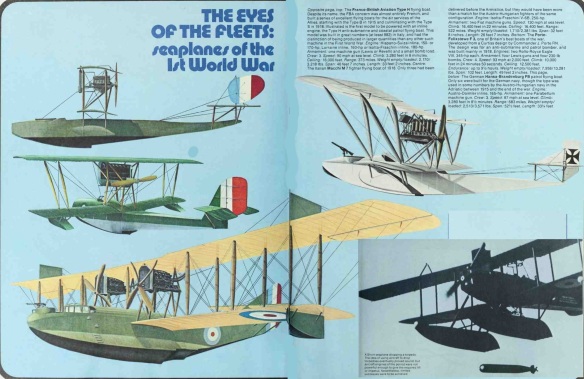With balloons having been used for observation purposes by the U. S. Navy in Mississippi during the siege of Island No. 10 in the American Civil War of 1861-1865, the Russian and Japanese navies in the Russo-Japanese War of 1904-1905, and the Italian Navy in the Tripolitan War of 1911-1912, it is not surprising that the major naval powers were quick to realize the advantage that aircraft could bring in extending vision beyond the immediate horizon and identifying enemy ship movements. Although successful experiments had been made in taking off and landing on ships prior to World War I, the limitations of both aircraft performance and ship design made ship-to-ship flight haphazard until the launching of the first purpose-built aircraft carrier, the Royal Navy’s H. M. S. Argus, in 1918.1 As a result, naval powers relied upon two main types of seaplanes: floatplanes employing externally attached floats or flying boats. These seaplanes operated either from coastal naval air stations or from ships, which either towed them or carried them onboard and used a winch and beam system to hoist them into or out of the water. During World War I, seaplanes would prove to have just as important an impact-albeit not as spectacular or as glamorous-upon naval warfare as did land airplanes upon land warfare. Seaplanes played an important role in transforming naval warfare by helping fulfill the traditional naval objective of establishing control or command of the seas, protecting coastlines and shipping lanes, and offering the possibility of projecting naval power inland through the air. Had the war continued into 1919, the British would have been able to mount carrier-based air attacks against the German Fleet. Such an ability was far beyond the capacity of 1914 seaplanes, thus demonstrating the impact that the war had upon technology.
The first aircraft that would now be identified as maritime patrol aircraft were flown by the Royal Naval Air Service and the French Aéronautique Maritime during World War I, primarily on anti-submarine patrols. France, Italy and Austria-Hungary used large numbers of smaller patrol aircraft for the Mediterranean, Adriatic and other coastal areas while the Germans and British fought over the North Sea. At first, blimps and zeppelins were the only aircraft capable of staying aloft for the longer 10 hour patrols whilst carrying a useful payload while shorter-range patrols were mounted with landplanes such as the Sopwith 1½ Strutter. A number of specialized patrol balloons were built, particularly by the British, including the SS class airship of which 158 were built including subtypes.
Three distinct categories of combat aircraft emerged: long-range overwater reconnaissance and antisubmarine aircraft operating from shore bases, shorter-range floatplane reconnaissance and fighter aircraft, and ship-borne aircraft. Long-range flying boats (so called because their fuselages were shaped like the hull of a boat) were used extensively by the British. These pioneered the technique of searching for submarines with methodical, mathematically developed search patterns. The German navy made extensive use of reconnaissance and fighter floatplanes from Belgian coastal bases to counter Allied air patrols and coastal naval operations. Some of these, notably Hansa-Brandenburg machines designed by Ernst Heinkel, rivaled their land-based equivalents in performance.
Later in the war, aircraft were also developed specifically for the role including small flying boats such as the FBA Type C as well as large floatplanes such as the Short 184 or flying boats such as the Felixstowe F.3. Developments of the Felixstowe served with the Royal Air Force until the mid 20s, and with the US Navy as the Curtiss F5L and Naval Aircraft Factory PN whose developments saw service until 1938. During the war, Dornier did considerable pioneering work in all aluminium aircraft structures while working for Zeppelin and built four large patrol flying boats, the last of which, the Zeppelin-Lindau Rs.IV influenced development elsewhere resulting in the replacement of wooden hulls with metal ones, such as on the Short Singapore. The success of long range patrol aircraft led to the development of fighters specifically designed to intercept them, such as the Hansa-Brandenburg W.29
